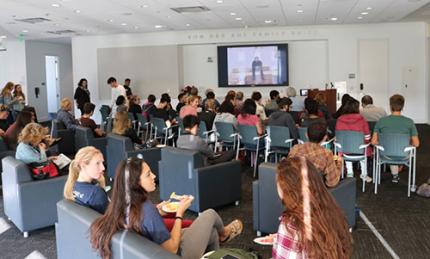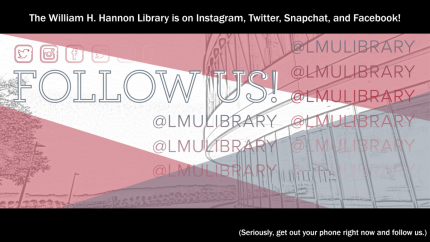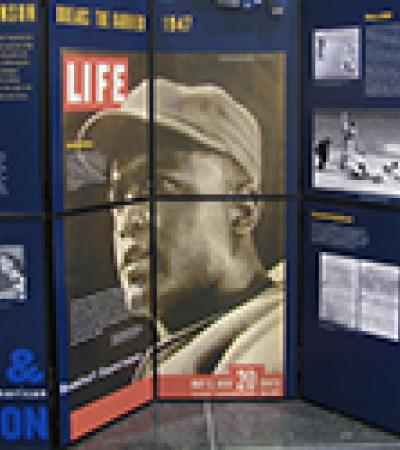
When I'm in the midst of hosting a library event — focused on making it a success — I often forget to think about what's coming next. It's often difficult for me to remember that each person sitting in the room at that moment has a greater potential for being a future audience member than someone who has never attended a library event.
So this year I'm developing ways to work subtle nudges into already existing program planning workflows to remind audience members about upcoming events happening in the library.
Pre-roll images
At the William H. Hannon Library, our main event space has a large digital display on two walls. Typically, this screen remains turned off during library events unless the speaker has requested it for showing a slide deck or film.
When the speaker does not have a digital object to show, the screen remains blank. This always feels a little awkward given how prominent the screen is compared to the size of the room. So this year I've begun creating pre-rolls — videos or slides advertising upcoming events — to play before each program begins.
Much like the advertisements, trivia questions and reminders to visit the concessions that you see before the previews in a movie theatre, my pre-roll decks contain images for the current event, a reminder to follow the library on social media, and images promoting upcoming events.
Putting these pre-rolls together requires a not inconsequential amount of time, so for now I am recycling images that we are already creating for our website homepage and the digital displays in our library lobby. Each image is pasted into a PowerPoint slide, and the deck is set to cycle continuously until I hit the pause button (which, unless the speaker plans to use the screen, will be paused on the image for that day's event). It takes me about 15-20 minutes to create a deck in PowerPoint with these pre-existing images, but creating a slide from scratch would require more time.

Event correspondents
This year, we are exploring new ways to collect feedback about library programs. We are enlisting library student workers, most of whom already work as our library student ambassadors, to work as event correspondents during library programs.
Before and after a library event, we ask our correspondents to interact with the audience — to ask questions about their experience, why they decided to attend the event, and what their overall impression was of the program. We are also asking these students to find out if attendees would be interested in attending upcoming events.
The correspondents then summarize their findings (in 400 to 500 words) within five days of the event and email them to library staff. Our hope is that their findings will help us identify the best audiences to target to when promoting related events.
Printed fliers on the seats
As much as I tend to discourage the use of printed fliers, in my experience they are most useful when placed directly into the hands of library user. Having a handful of fliers for upcoming events available either at the entrance to an event or on the audience members' chairs is an easy way to let your audience know about future events of interest. It also almost guarantees they will read the flier if they have to remove it in order to sit down. Sure, they may throw it away, but that still counts as an eyeball.
E-newsletter signup everywhere
Set out paper sign-up lists. Add a form to your website events page. Post regular social media reminders (especially right before a new issue is released). Add "subscribe" checkboxes at the end of feedback forms.
Anywhere you can collect and remind your patrons about your email list, sign them up. Not everyone will open your newsletter. Some may even unsubscribe after the first email, but simply hitting their inbox on a regular basis will have a cumulative effect on their level of awareness about library programming.
Building an audience for library programming is a long-term project. It takes continuous attention, regular finessing and ongoing outreach to make sure your audience remains robust, engaged and informed. This is especially true for academic librarians who cycle through completely new student audiences every two to four years. Anything you can do to nudge your audience toward attending a future event, no matter how subtle, is worth the effort.


